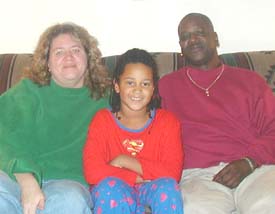 |
|||
|
Politics
Related Links: |
|
For Growing Number of Multiracial Couples, It's Not a Black-and-White World
By Carla Correa GAITHERSBURG - Angela Conrad remembers staring at her daughter's kindergarten registration form and trying to decide -- was Lyric white like her, or black like her father? "I checked both white and black on the boxes," Conrad said. "They said, 'No, you can't do that.' " She eventually decided on black -- she wanted to acknowledge that Lyric, now 8, was not just white -- even though Conrad is pretty sure that hospital officials listed Lyric as white when she was born. "They're almost forced to make a decision like that," Conrad said. Conrad is not alone. The 2000 Census showed that 6.3 percent of Maryland households are married couples of different races or origins. The number increases to 11 percent for non-married couples who share a household, like Conrad and Lyric's father, Arthur Forney. And Lyric is not alone, either. The Thurgood Marshall Elementary School second-grader has friends who come from a variety of backgrounds, too. "We had a slumber party here, and I swear it was like a United Nations," Conrad said. The family lives in an apartment in Gaithersburg, an area brimming with diversity. They feel comfortable there -- they say discrimination is not a part of daily life. But there have been times -- primarily when the couple lived in Pennsylvania -- when Forney, 43, and Conrad, 34, noticed the disapproving stares of passersby. Conrad partly blames television programs, like talk shows, that she said perpetuate that stereotype that black men only take advantage of white women, instead of exposing the public to interracial couples in successful relationships. But an interracial relationship was something that neither Forney nor Conrad, who were raised in and around Harrisburg, expected. "I would look at an interracial relationship," she said, "and say, 'What are they doing?'" Conrad said she had never spoken to a black person until her freshman year at Pennsylvania's Loch Haven University. And Forney said he had little interaction with whites until he left Harrisburg to join the Army. "That's when things changed for me," said Forney, the great-grandson of slaves in North Carolina. "Up until that point, the only interaction I had with a different race would be at a grocery store or some place like that." After the Army, he held a multitude of jobs -- including truck driving -- but no longer works due to health problems that include severe arthritis and multiple sclerosis. The two did not know each other as children. They met more than 10 years ago on a motorcycle trip to New York and reunited about a year later in a pool hall -- after Forney had split from his wife, who is black and with whom he has three children. Conrad and Forney started dating, had Lyric and, about a year ago, moved in together. Conrad said her family was not thrilled to learn that she dating a black man -- much less that she was expecting his child. While some have come around, she concedes that a handful of family members and acquaintances may still not approve. "I think it's easier said than done -- until it hits your household," Conrad said. "I think most people's true colors have shown up over the years." "They got to know me," Forney said about Conrad's parents. "(Now) it's not a thing about color." And Lyric, who spends every other weekend with her maternal grandparents, has brought the extended family closer together. "Once Lyric was born, all the magic was in her," Forney said. Living in Montgomery County helps, they added. Conrad could only recall one incident since the family moved to Maryland, when the mixed-race family ran into a group of high-school-age girls during a visit to Baltimore's National Great Blacks in Wax Museum. "This one black girl was like, 'Oh I hate that,' " she said. "We just moved on away from them." The different skin colors in the family are not a factor for Lyric, her parents said. "If someone was slighting her, she wouldn't even realize it," Conrad said. "One girl said to her, 'Your dad is black. Your mom is white.' Lyric was kind of like, 'Alright.' " Copyright © 2003 and 2004 University of Maryland College of Journalism
|

